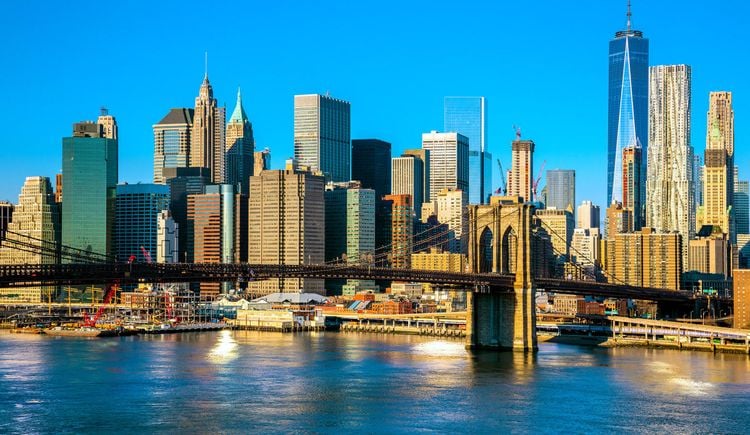You can only get to know a destination through the experience of living there, or even through travel, through its literature, through meeting its people, through the connection you can establish with them and their culture. But for the United States, the rule seems a little different because its cinema, often framed within a sociological field that is both marked and well-defined, is as diverse as it is rich. It provides us with a wealth of windows through time, its territories and its ethnic groups. Many of them are adaptations of its literature, or productions by great filmmakers. Or both.
There are few great countries that can be discovered, and then known, through their film, in terms of their geography, culture and history, as well as their mentality and political fabric. America**, by virtue of the size of its film industry and its need for memorial introspection, is one of these countries, with a richness, precision and depth that are unequalled.
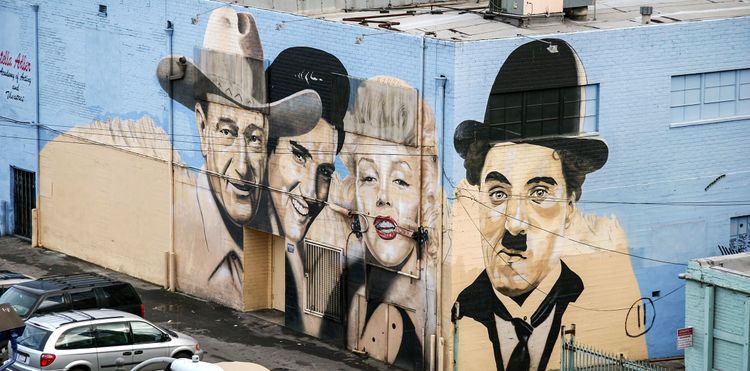
Les superstars US: John Wayne, Elvis Presley, Marilyn Monroe et Charlot.
- © Víctor Hugo Garibay Sandoval / 123RFThe American saga
This film tells us about the conquest of the West and the expropriation of the Indians, colonisation, the melting pot and the establishment of immigrant communities, living conditions on Indian reserves, but also in the countryside and in the counties, and the evolution of the Black community over time, the birth of negroes imported fromItaly,Central Europe orAsia, with their impact on the big cities, the gang phenomenon and its gangrene among young people, the ravages of drugs, criminology, the consequences of the wars waged across the Atlantic and the tentacular unbridled capitalism invented here, like so many other things...
In short, its cinema and literature are the great history books of the USA.
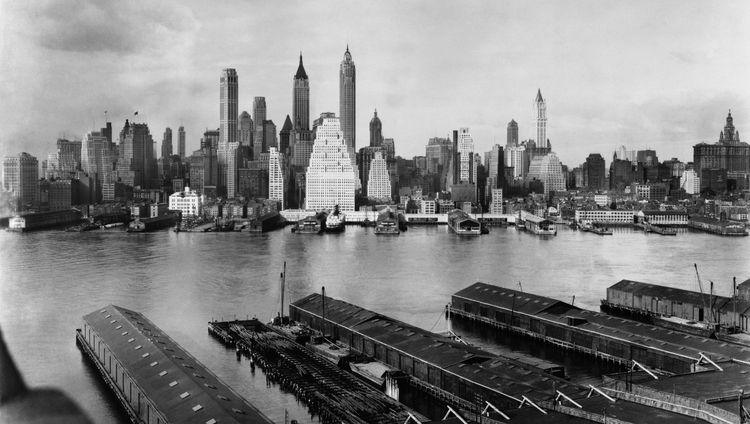
It all starts in New York
Martin Scorcese is a true painter of American society. He also has a flair for drama. In 2002, the filmmaker met with renewed success with his film ** Gangs of New York**, which tells the story of the bitter dispute over territory on the island of Manhattan between the English and the Irish in the 1850s. This Manhattan has little to do with today's Manhattan, but it is full of lessons about the political and territorial rivalries that existed between the two communities at the time. It has to be said that Scorcese is not adapting a novel here, but a very serious study by journalist and historian Herbert Asbury, published in 1927.
This requires us to delve a little deeper into the history of the East Coast. The first settlements were in Florida in 1565, in Saint-Augustine, and in Plymouth in 1620 by the Pilgrim Fathers. The Bay of New York, then known as New-Angouleme, was discovered in 1524 at the instigation of the French king François I. This was Lenape (Delawares) territory, where the natives had always lived. This was Lenape (Delawares) territory, where the native people had always lived.
A number of cowboy films were shot in this time and place, but it wasn't until Michael Mann's wonderful ** Last of the Mohicans** in 1992 that a faithful account of the events of the time was brought to the screen. This eleventh adaptation of James Fenimore Cooper 's famous novel recounts the confrontation between the French and English at the time of the Battle of Fort William Henry (1757) in the province of New York, and the disastrous consequences for the Indian tribes taking part in the conflict. The Huron-Wendat were allies of the French, while the Mohicans lent their support to the English, and more specifically to Colonel Monro's daughters. The conflict between the Europeans led to bloody clashes between the Indian tribes.
The Oscar-winning Daniel-Day Lewis lends his features, and his exceptional acting, to the character of Hawkeye, as he did with Scorcese in "Gangs of New York", but he will also be seen as Abraham Lincoln in Steven Spielberg's 2012 film.
As for Martin Scorcese, he continues his introspection of America's knotty history by revealing to us in 2023 the murder ofOklahoma Amerindians who had found oil on their land in the 1920s, in the film Killers of the Flower Moon. A true story.
The Conquest of the West
Everyone is familiar with this period inAmerican history. But what is less well known is that the Americanfilm industry, having produced a number of silent films on this theme, played a major role in extending this conquest even further by extending its activities to the West Coast. Production studios were located on the East Coast, particularly in New York, and artificial sets were used to simulate the vast expanses ofArizona and Nevada.
From the beginning of the 20th century, producers were attracted by the West Coast, the low cost of property, cheap labour, the riviera-like atmosphere of Los Angeles and, above all, the absence of trade unions. They began to set up shop. As cinematography improved (with the advent of talking pictures in 1927, followed by Technicolor), producers were encouraged to shoot in natural environments. The entire industry moved its offices to California, where all the filming would take place. Hollywood was born. And it became one of the country's leading industries.
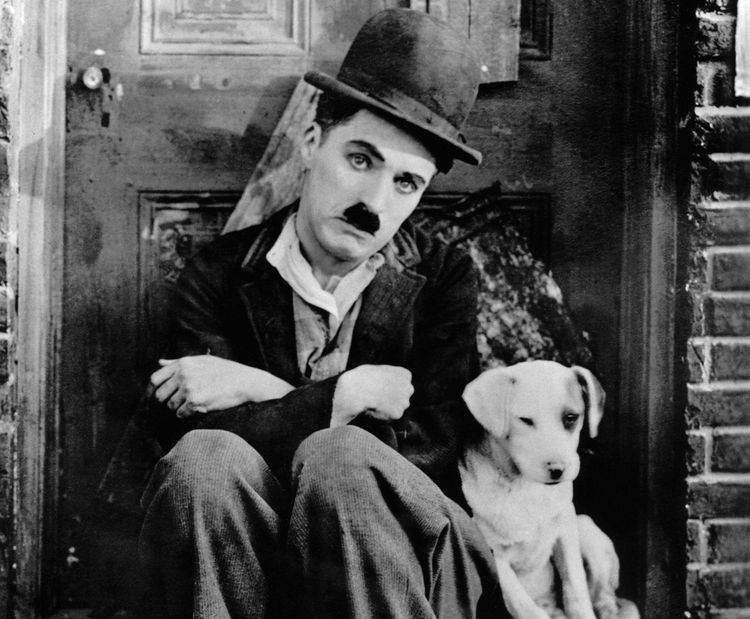
Charlie Chaplin émigre à Los Angeles en décembre 1913 où il fondera United Artists, avec ses amis stars Mary Pickford et Douglas Fairbanks Jr. Superstar du cinéma muet, il sera pourtant expulsé du territoire en 1952, victime du maccarthisme !
- © First National StudiosIn 1938, at a time when the Western genre was in full swing, John Ford, a talented filmmaker who excelled in the genre, set off early in the morning to find a setting worthy of the formidable Dantesque ride he had imagined for his film"La Chevauchée Fantastique" (1938), with his friend John Wayne. He entered the Navajo lands betweenUtah andArizona and discovered a desert plateau from which emerged several monumental rocks that the Navajos called "The Great Indian Chief", "The Cowboy Boot" and "The Imperial Eagle". John Ford was gripped. He had found what he was looking for. To thank the Navajos, he gave them the role of the Apache villains in his film. And so it was that a place known only to the Navajos and a few cowboys became Monument Valley, one of the most iconic landscapes in the USA.
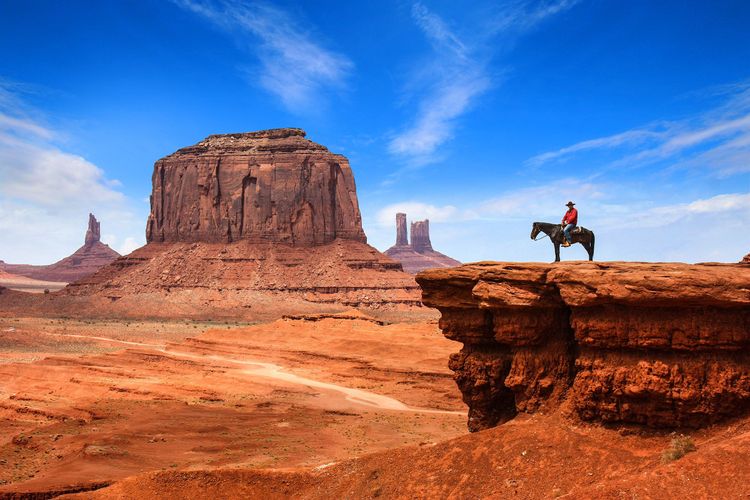
In Monument Valley, this viewpoint is named "John Ford Point", in tribute to the director.
- © MisterStock / ShutterstockIn 1956, he filmed "The Prisoner of the Desert", again with John Wayne, who was then both the archetypal American hero as a character and the integrated representative of Irish emigration as a showbiz personality, just like John Ford.
At the time, cowboys in westerns, who didn't keep any cows, were seen as vigilantes, shooting Indians with no qualms. It was in the 1970s that a new generation of Americans began to question the patterns hitherto imposed by thefilm industry: just because Manichaeism was the order of the day in Hollywood didn't mean that Indians had to be made villains.
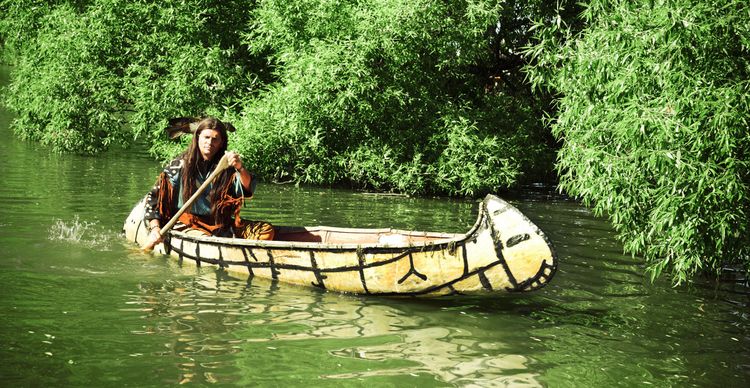
In 1970, E. Silverstein's AManCalled Horse tells the story of an English lord who is kidnapped by the Sioux in their territory, where he had come to hunt shamelessly with his companions. Silverstein tells the story of an English lord who is kidnapped by the Sioux on their territory, where he had come to hunt shamelessly with his companions. To teach him life and good manners, the Sioux reduce him to a slave and put him through all the rituals, some of them cruel, that will make him one of them. A symbolic way of putting the settlers in their place. But also to integrate them.
In 1980, Michael Cimino, one of Hollywood's promising new guard, directedHeaven's Gate, a grandiose film recounting the war in Johnson County, Wyoming (1889-1893), the confrontation betweenEastern European emigrants seeking to establish themselves in theWest and wealthy landowners of Germanic origin who "savagely" privatised the county land that they felt was rightfully theirs, for reasons of racial supremacy. Isabelle Huppert is in the cast.
Underworld, corruption and unbridled capitalism
The same Cimino, who made only 8 films in his entire career but left an indelible mark on the history of cinema, wrote and directed "Year of the Dragon" in 1985, a brilliant adaptation of the novel "Year of the Dragon" by Robert Daley. The film plunges us into the heart of New York's Chinatown, a city within a city. Far from being a tourist postcard, and as with his previous film, Cimino plunges us into the tragedy of human conflicts caused by the clash of cultures, the conquest of territories and the exploitation of man by man. The law of the strongest prevails, again and again.
Stanley White, the cop (Mickey Rourke), is a Vietnam War veteran of Polish origin determined to bring order to Chinatown. But the Chinese underworld, operating out of Hong Kong, is having none of it. To make matters worse, Stanley White falls in love with a beautiful journalist from theChinese immigrant community, who of course has strong ties to his community. A sort of Romeo and Juliet 2.0 (two years later, Abel Ferrara shot hisChina Girl, about the impossible love affair between an Italian from Little Italy and a Chinese woman from Chinatown).
At the end of the 19th century, the underworld was mainly to be found in the North, particularly in Chicago where Al Capone was rampant, and on the East Coast, where the Jewish and Italian mafias were based.
For a long time, gangster films (mob movies) were so-called genre films, i.e. coded cinema that repeats itself while seeking to renew itself. Numerous in the silent era, these films arrived in the talking era with the same actors, directors and producers. Such was the case withHoward Hawks ' "Scarface" in 1932, an adaptation of the life of Al Capone, who had been convicted the previous year after keeping the Chicago feds at bay for a long time. It was an opportunity to show the rest of America that not only did the authorities always get their way, but also the exceptional architecture of this megalopolis, which already rivalled New York in its excessiveness.
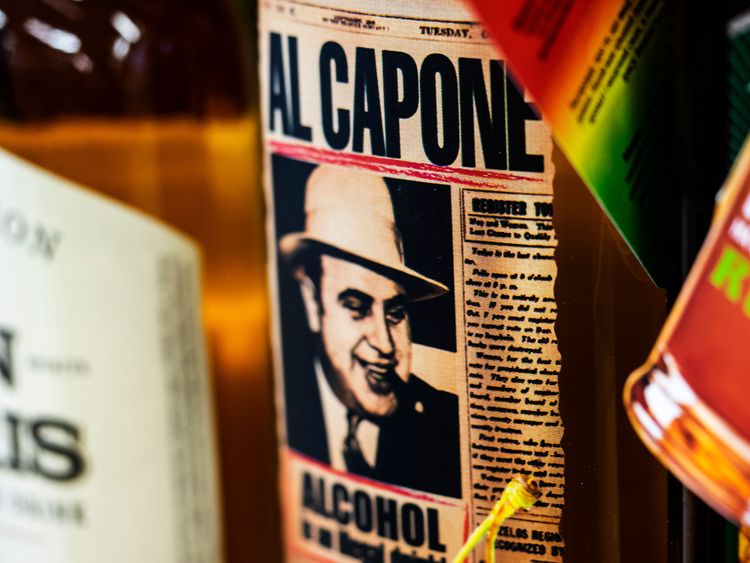
Al Capone
- © IgorGolovniov / ShutterstockThe film made an indelible impression, and years later Brian de Palma delivered his "Scarface", a free adaptation of the film, followed by "The Untouchables " (starring Kevin Costner and Sean Connery), an adaptation of the TV series of the same name, which recounted the hunt for the mafia, andAl Capone in particular, by agents of the US Treasury during Prohibition. In the first film, De Palma decided to make his gangster, played by Al Pacino, a Cuban immigrant operating in Miami, rather than an Italian based in Chicago.
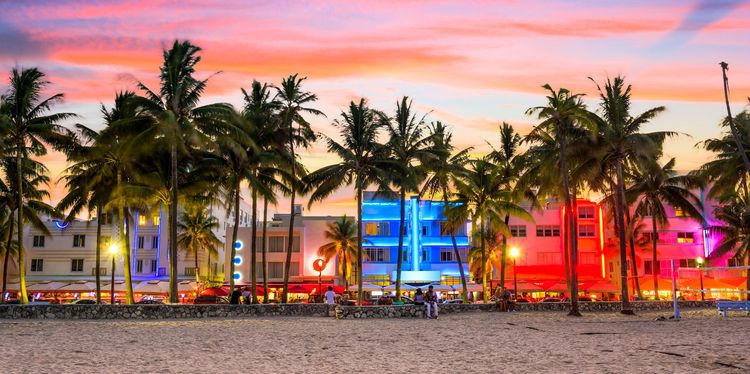
Miami and its colorful Art Nouveau buildings.
- © Sean Pavone / ShutterstockIn this genre, which constantly sheds light on the corruption of the police and the ramifications of the underworld throughout the country, there are other films worth mentioning, such as the remarkable biographies: Sidney Lumet's "Serpico", again with Al Pacino, or"Bugsy", in which Warren Beatty plays the gangster Bugsy Siegel, who created the city of Las Vegas, where he was finally eliminated by his peers.
Francis F. Coppola 's "TheGodfather" and its sequels may be works of fiction, but they provide us with a masterly documented vision of the history of the Italian mafia's presence in the USA. To achieve this realism, Coppola filmed on location in the Lower East Side, in particular 6th Street and Mott Street, between Little Italy and Chinatown. The son of the godfather, Michael Corleone, receives his decoration in the famous St Patrick's Cathedral on 5th Avenue.
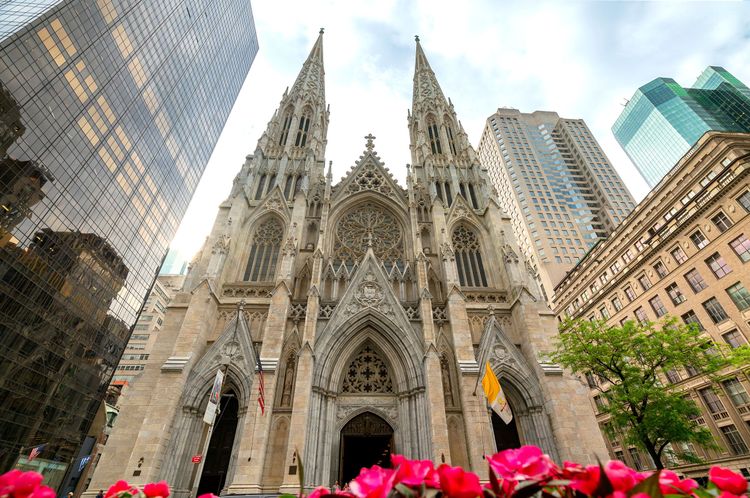
St. Partick's Cathedral on 5th Avenue.
- © HannaTor / 123RFA few years later, in 1985, the immense Coppola returned to this place and this era with his grandiose"Cotton Club", a jazz club run by the mafia that actually existed during New York's Prohibition era. Duke Ellington and Cab Calloway performed there (George Gershwin, Louis Armstrong and Sidney Bechet also played there), as did Charlie Chaplin and Gloria Swanson. This was a time when blacks and whites neither mixed nor rubbed shoulders. As Coppola shows, the blacks were on stage and the whites at the show.
20 years later, when Marilyn Monroe learned that the Mocambo, the famous whites-only club in Los Angeles, was refusing to allow Ella Fitzgerald to perform there, she intervened with the owner and got her hired (but in exchange had to promise her own presence in the club for each new performance). Thanks to her, the immense black artist began her national and then international career.
The American human condition
If American literature has always nourished its cinema, it is first and foremost because it is the historical testimony of its society.
Hollywood has seized on all its authors: Jack London (The Call of the Wild), Fenimore Cooper (The Last of the Mohicans), Mark Twain (The Adventures of Tom Sawyer), Scott Fitzgerald (Gatsby the Magnificent, The Curious Case of Benjamin Button, The Last Mogul), Pulitzer Prize winner John Steinbeck (The Grapes of Wrath, Of Mice and Men), Ernest Hemingway, (For Whom the Bell Tolls, The Snows of Kilimanjaro), Daphne du Maurier (The Birds, Rebecca), Tom Wolfe (The Bonfire of the Vanities), John Irving (The World According to Garp, Hotel New Hampshire), Stephen King (Dolores Claiborne, The Shawshank, The Shining) and Russell Banks (A Beautiful Tomorrow, Affliction). They are all painters of the human condition.
The cinema of the 70s, eager to be at once realistic, fair and open to the future, produced many outstanding films. They dealt with misery in a world that promised the best, class warfare, white-collar criminals and the insolence of money, political wheeling and dealing and the Vietnam War! This is how Michael Cimino - once again - made his name in 1978 with"Journey to the End of Hell" (The Deer Hunter). For the first time, Hollywood told us about the post-traumatic stress suffered by soldiers returning from war. The film is poignant and forces us to open our minds to the blind spots in our lives. The theme of the trauma of war would later be used extensively in literature and film.
Four years later, we find this theme again in"Rambo", where this peerless soldier breaks down in tears at the memory of what he experienced on the Vietnam front, in a war that was not his own. It was an opportunity for the whole world to learn that Vietnam veterans had often become outcasts, even pariahs, in their own country. Oliver Stone will be making a film on this theme with"Born on the 4th of July", adapted from an autobiography, starring Tom Cruise in the role of veteran Ron Kovic.
In 2020, the prolific and innovative Oscar-winner Steven Soderbergh delivered two highly documented accounts of social issues with"Traffic", about the ramifications of drug trafficking throughout the United States, and"Erin Brockovich", about water pollution causing cancer in the countryside, and a mother's battle to obtain compensation from the factory responsible. Several films in this vein followed. These include"Contaminations", about the contamination of groundwater and the consequences for crops, and"Crisis", about the trafficking of powerful painkillers. In terms of scandals based on real events, Spotlight investigates paedophilia in Boston parishes in the 70s and 80s.
In recent years, cinema seems to have delegated to TV series this duty of remembrance and of putting human adventure into perspective. 30 years ago, Steven Spielberg and Michael Crichton, the author of Jurassic Park, conceived and produced the series ER, which dramatised the emergency room at Cook County Hospital in Chicago, with all its human drama and emotion. The series lasted because everyone could relate to it. Crichton knew his subject, having been a young doctor before writing scripts for Hollywood. John Carter was a bit like him in his early days.
At the same time, producer Dick Wolf launched a detective series, Law & Order, which was both highly realistic and well documented. It explains the American legal and criminal justice system. Produced on location in New York City, either hand-held or in flats, it was not very expensive to produce. What's more, it employs outstanding actors and scriptwriters. The plots are well-crafted and the twists and turns against a backdrop of legal arcana are unforeseeable!
The success of the series led to the creation of no fewer than 7 spin-off series. After 1,300 episodes, the series is still as captivating as ever, 30 years on. We now know all about the American legal system and its laws. And we've seen New York from every angle. The same goes for American citizens from all walks of life, who now have access to a complete knowledge of the arcana of their country.
In a different vein, the series'Malcolm' was certainly humorous and sometimes slapstick, but it broke new ground by painting a detailed picture of the American working and middle classes. Humour was used to tackle serious, even grave subjects: poverty and the tensions it engenders in the home, education, class struggle, inequality and illness, but also purely human themes such as parents, stupidity, greed, jealousy, ambition, the intrinsic differences between individuals, as well as malice, the spirit of revenge, brotherhood and resilience.
"The Good Fight", currently being produced by the immense Ridley Scott, explores the world of Chicago business, through the expansion of a large law firm run by African-Americans, their sometimes ideological battles, an acid critique of Trumpism, the ravages of fraud and police violence against blacks. In the same vein, the series"Goliath" recounts the modern battle of David against Goliath through the rebirth of a leading barrister. The struggle of the little people against the toxic greed of big business, which seems to stop at nothing.
